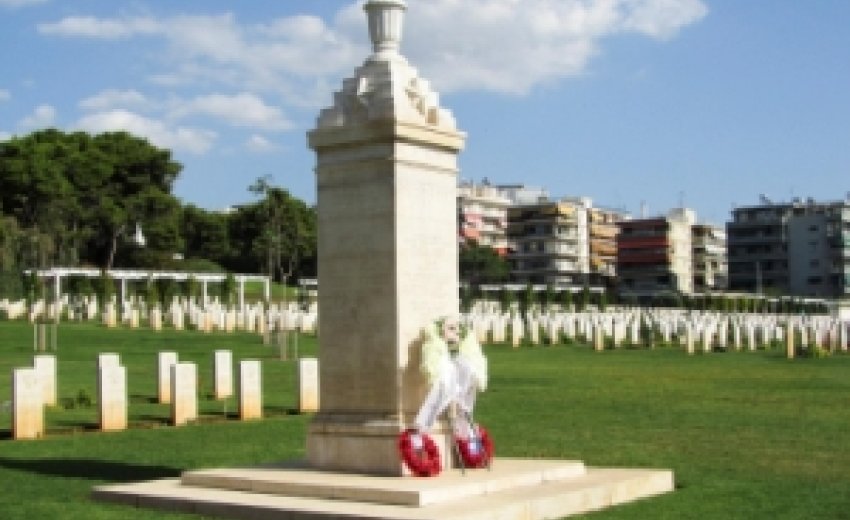Sikh Community Group Visit the Phaleron War Cemetery and Phaleron Cremation Memorial, Athens, Greece.
On Thursday 18th October 2012, a delegation from Sikh Community of Birmingham, UK and Sikhs from Shiri Guru Nanak Darbar, Tavros, Athens, visited the Phaleron War Cemetery and Phaleron Cremation Memorial to pay respect to the brave soldiers and servicemen who laid their lives in World War two campaigns in Greece and Crete. The group was joined by Beverley Lewis OBE, regional consul for Greece and Cyprus from British Embassy and by Mr Manolis Tsoulos, local supervisor from commonwealth war graves commission. This was group's first visit to this war cemetery and memorial. They all gathered together around half past one in the afternoon, observed the cemetery, graves and name panels. Individuals expressed their own emotions and pondered in the past. Then the remembrance ceremony was started with a prayer near the Phaleron cremation memorial. To pay tribute to the brave soldiers and servicemen who had come so far away from home and fought for a cause they may not have comprehended, in a sombre ceremony a poem of victory was recited: 'Deh Shiva Bar Mohe Eha' meaning:
O Lord, give me this boon
May I never ever shirk from doing good deeds
Never may I fear when I go to fight the enemy
With surety, victory will be mine
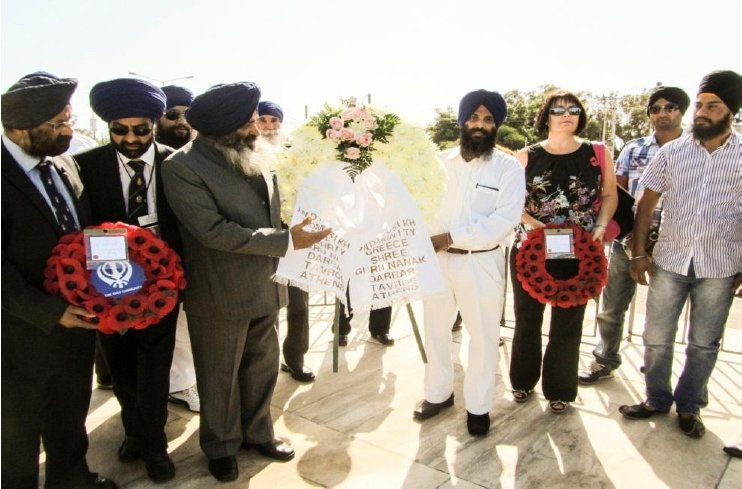
This was followed by the laying of the wreath by Ms Beverley Lewis at the Phaleron cremation memorial, followed by the laying of the wreath by Mr Ranvir Singh Virdi and Mr Dal Singh Dhesy, members of the Royal British Legion (Birmingham branch) and of Sikh Community and Youth Services UK. Then another wreath was laid by Mr Jagpravash Singh (Victor), president of Shiri Guru Nanak Darbar, Tavros, and Rejbir Singh from the Gurdwara in Athens.
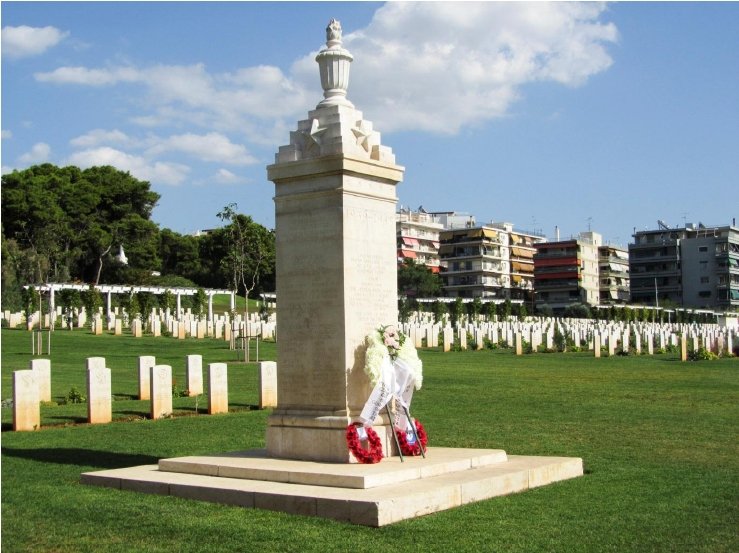
The Phaleron Cremation Memorial
The four sides of the Phaleron Cremation Memorial was carefully viewed and studied. The following information on Indian forces and names is engraved on the four faces of the marbled Phaleron cremation memorial:
First face:
1939-1945
Indian forces:
Indian Armoured Corps, 2nd Royal Lancers (Gardner's Horse)
Sowar: Mahabir Singh
The Central India Horse (21st K.G.V's. o. Horse)
L.C.E. Daffadar : Jage Ram
Sowar: Bhula Ram, Bir Singh
The Corps of Royal Indian Engineers
Havildar: Jaganathan
Q.V.O. Madras Sappers and Miners
Sapper: Arumugam, Doraiswami, Murugesan, Palaniandi
K.G.V's O.Bengal Sappers and Miners
Havildar: Bhawani Datt
Second Face:
In honour of these soldiers who died in battle and whose mortal remains were committed to fire.
Indian forces:
Corps of Indian Electrical and Mechanical Engineers
Naik: Maruti chawan
Sepoy: Bakhtawar Singh
Craftsman: V.B. Shindekar
Non-combatant: Babu phulekar
Indian Pioneer Corps
Pioneer: Bije Singh, Dunia Gura
Indian States Forces: 4th Gwalior Maharaja Bahadur Battalion
Liutenant: Krishnarao Jadhav
Havildar: Kalyan Singh
Lance Naik: Niwaratirao Kamle, Trimbak Rao Chawan
Sepoy: Abajirao Shinde, Appanarao Dasav, Baburav Dewarde, Dhir Singh, Jadan Singh, Mo-rorao Naiwade, Rajaram Rao, Shambaji Rao Gaonker, Shivram Rao Jadhao, Vishnu Ma-hadeo Bhonsle.
Third Face
Indian Forces:
11th Sikh Regiment
Havildar: Dalbara Singh, Gurdayal Singh
LCE Havildar: Niranjan Singh
Sepoy: Harkishan Singh, Mohinder Singh, Rup Singh
12th Frontier Force Regiment
Sepoy: Khazan Singh, Barkat Ram, Dalgit Singh, Hardayal Singh, Hira Ballabh
Non-Combatant: Lal
Royal Indian Army Service Corps
Jemadar: P.B. Somayya
Sepoy: Ganesh Chaubey, Giani, Gopal Singh, Sher Singh
Havildar: Gurbakhsh Singh, Rajendra Nadar, vasudeo heblikar
Non-Combatant: Bindu, Girdhari Lal
Naik: Dalip Singh
Indian Army Medical Corps
Sepoy: Shambu Singh
Indian Army Ordance Corps
Havildar: S. Raghavan Nair, T.P. Sukumaran
Corps of Indian Electrical and Mechanical Engineers
Havildar: Anadi Nath Chatter Jee
Forth Face
(Hindi Script)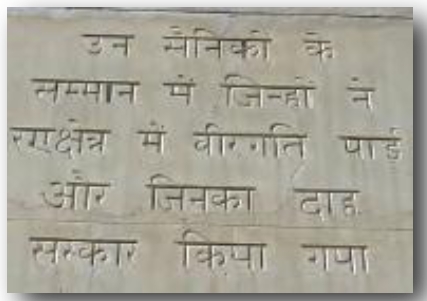 Indian Forces:
Indian Forces:
The Corps of Royal Indian Engineers, Royal Bombay Sappers and Miners
Lieutenant: Lalit Mohan Pant
Jemadar: Amrit Khan Wilkar
Sapper: Ganpat Jadhao
Indian Signal Corps
Naik: Arjun Das
Non-Combatant: Bhunda
6th Rajputana Rifles
Havildar: Phul Chandran
Rifleman: Hakam Chand, Jodha Ram, Lachhman Ram
8th Punjab Regiment
Non-combatant: Babu Lal
10th Baluch Regiment
Sepoy: Bhagwat Parshad, Mangal, Narayan Das, Ram Awadh, Ram Partap, Ruplal.
For information, the Indian military ranks and their British equivalents are given below:
(Ref: Sikh Soldier, Volume Two, Gallantry Awards by Narindar Singh Dhesi)
ARMY
Viceroy's Commissioned Officers
Indian Infantry Indian Cavalry British
Subedar Major Risaldar Major Major
Subedar Risaldar Captain
Jemadar Jemadar Lieutenant
Non-Commissioned Officers
Havildar Major Kot Daffadar Sergeant Major
Havildar Daffadar Sergeant
Naik Lance Daffadar Corporal
Lance Naik Acting Lance Daffadar Lance Corporal
Sepoy Sowar Private
The ranks for NAVY and AIR FORCE are the same as and equivalent to the British.
At the end of the remembrance ceremony an appreciation award from the Sikh Community & Youth Services UK was presented to the British Embassy for their services to British Citizens in Greece, the award was accepted by Ms Beverley Lewis on behalf of the Embassy. Mr Manolis Tsoulos, local su-pervisor from Commonwealth War Graves Commission was acknowledged for his continued work in maintaining the cemetery. He was thanked for his attendance and support.
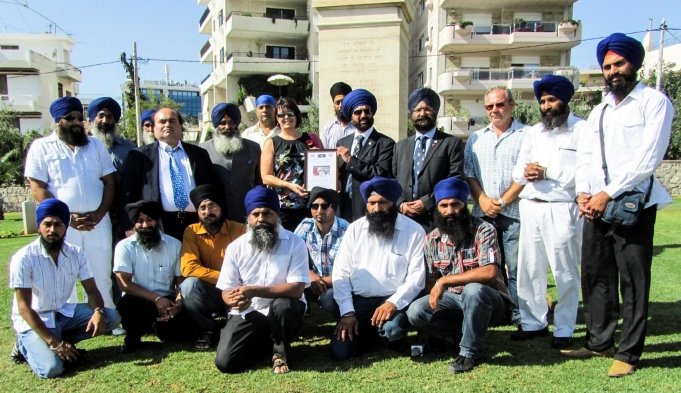
In remembrance and honour
In remembrance and to pay respect to those who made the ultimate sacrifice for Greece and Eu-rope's freedom many other individuals joined in the ceremony, they were: President of Shiri Guru Nanak Darbar, Tavros, Athens, Mr Jagpravash Singh (Victor), Mr Rajbir Singh, Mr Jarnail singh, Mr Balbir Singh, Mr Gurpal Singh, Mr sukhraj Singh, Mr Parmjit Singh, Mr Gurbax Singh, Mr Jaspal Singh, Mr Sanjeev Kumar, Mr Nirphah Singh, Mr Gurmej Singh, Mr Harbhajan Singh, Mr Jaswant Singh, Mr Jaswinder Singh, Mr Sharan Singh, Mr Harkirpal Singh, Mr Fotis Bombanis (Lawyer).
We hope our visit from the UK has raised awareness within the local community of the sacrifices made by all soldiers and servicemen during the World Wars. We hope that this awareness will, in turn, improve community relations in Greece.
Remembering and honouring the fallen is the greatest tribute we can give to all those who gave their lives for our tomorrow. The Sikhs in Greece and elsewhere will continue to pay respect to the fallen in the future.
YouTube video relating to the above event can be seen here:
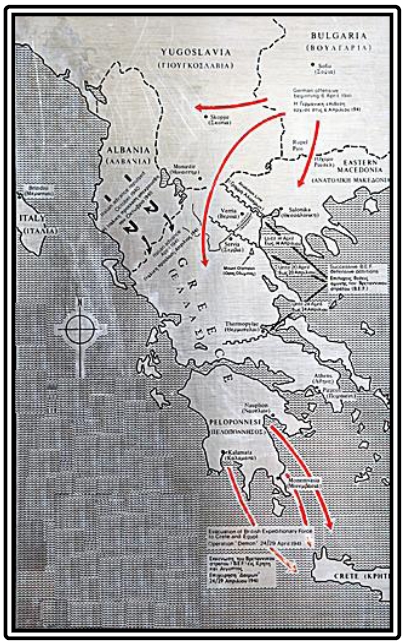 The Campaign in Greece 1940 - 1945
The Campaign in Greece 1940 - 1945
In late October 1940 Greece was invaded in great force by Italy from Albania. By the year's end the Greek army, with the help of the Royal Air Force, had thrown back the invasion and occupied one quarter of Albania. The Italians received increasing German help and in March 1941 the Greeks asked for the assistance of a British Expeditionary Force (B.E.F.). This force the first Armoured Brigade group, the sixth Australian Division and the New Zealand Division - the better two reviving the famous title of Anzac Corps - had scarcely been deployed along a line south of Salonika before, on sixth April, the Germans invaded Greece in force through the Rupel Pass in the east and the Monastir Gap in the West. The eastern thrust compelled the surrender of the Greek Army in eastern Macedoniaon 10th April and Salonika was occupied. The strong German thrust in the west, coupled with an Italian advance from Albania, threatened to out flank the B.E.F. which withdrew on 14th April to a line north of Mount Olympus. Again out flanked the B.E.F. completed by 20th April a further withdrawal to a line across the peninsula at Thermopylae and the Greek Army to their west also withdrew. But the continued German and Italian attacks on the Greek Army, which had been fighting without respite for sixth months, overwhelmed it on 21st April and, the Thermopylae line thus becoming untenable, the B.E.F. started to fall back for evacuation. This withdrawal, without air cover, took place through the Peloponnese as the port facilities of Piraeus had earlier been destroyed in an air raid but, despite the difficulties, the Navy had, by 1st June, evacuate 50,000 men (5/6th of the total force) from the southern Peloponnese beaches and taken them to Crete or Egypt. The progressive liberation of Greece by the Commonwealth Force began on 24th September 1944 and met with little opposition from the retreating Germans.
Phaleron War Cemetery: The Athens Memorial and The Phaleron Cremation Memorial
The cemetery was made after the war and in it are gathered the graves of the Commonwealth causalities of the 1941 campaign and of the period from 1944 onwards.
Two memorials stand in the cemetery: the Athens Memorial commemorating Commonwealth soldiers who fell in Greece, Crete, the Dolecanese and Yugoslavia from 1941 to 1945 and whose graves are unknown, and a Cremation Memorial to those soldiers whose remains were cremated.
The Phaleron War Cemetery
Historical Information 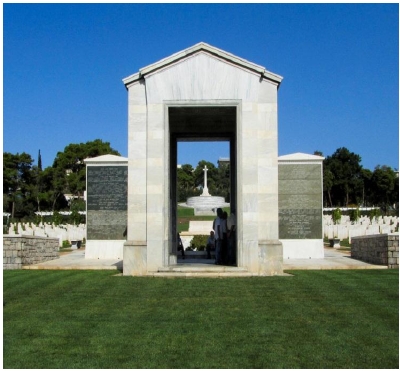 The site of what is now PHALERON WAR CEMETERY was chosen originally by the 4th Division as a burial ground for Commonwealth casualties of the Greek Civil War (December 1944-February 1945). Subsequently, the military authorities, in conjunction with the Greek Government and the Army Graves Service, decided that it would be the most suitable site for a Second World War cemetery for the whole mainland of Greece. The 23rd and 24th Graves Registration Units and the 21st and 22nd Australian War Graves Units worked together to bring in graves of the 1941 campaign from the battlefields, temporary military cemeteries and from various civil cemeteries.
The site of what is now PHALERON WAR CEMETERY was chosen originally by the 4th Division as a burial ground for Commonwealth casualties of the Greek Civil War (December 1944-February 1945). Subsequently, the military authorities, in conjunction with the Greek Government and the Army Graves Service, decided that it would be the most suitable site for a Second World War cemetery for the whole mainland of Greece. The 23rd and 24th Graves Registration Units and the 21st and 22nd Australian War Graves Units worked together to bring in graves of the 1941 campaign from the battlefields, temporary military cemeteries and from various civil cemeteries.
The cemetery is laid out symmetrically in 16 plots, with the Cross of Sacrifice in the centre. There are now 2,029 Commonwealth servicemen of the Second World War buried or commemorated in this cemetery. 596 of the burials are unidentified. Special memorials commemorate casualties known to have been interred in certain groups of graves in the cemetery, but whose individual graves cannot be precisely located within these groups. Other special memorials commemorate casualties re-buried in the cemetery from original graves which, owing to the destruction of local records, could not be identified. Also within the cemetery are:
The ATHENS MEMORIAL, commemorating nearly 3,000 members of the land forces of the Com-monwealth who lost their lives during the campaigns in Greece and Crete in 1941 and 1944-1945, in the Dodecanese Islands in 1943-1945 and in Yugoslavia in 1943-1945, and who have no known grave. Information panels within the memorial, in English and Greek, provide a brief history of the campaign. The numbered double-sided plinths list caasalities by regiment and are a constant reminder of personnel from various nations who gave their lives during the conflict.
The PHALERON CREMATION MEMORIAL, commemorating 74 men of the army of undivided India who died during the campaigns in Greece and Crete during the Second World War and who were accorded the last rite required by their religion - committal to fire. Around this memorial 66 were buried and have small white gravestones. There are no small white standing gravestones of Sikhs in this cemetery. 56 others, for whom no last rites could be performed, have their names engraved on the memorial column at the Phaleron War Cemetery.
In the north-east corner of the cemetery, a plot contains the graves of servicemen and civilians who after serving in the Crimean War, died in Greece, and were buried in the Anglo-French Crimean Cemetery, New Phaleron. The graves were moved in 1966 when that cemetery could no longer be maintained.
Phaleron War Cemetery is permanently open and may be visited at any time, including weekends and public holidays. It lies a few kilometres to the south-east of Athens, at the boundary between old Phaleron district and Alimos-Kalamaki district, on the coast road from Athens to Vouliagmeni. Cemetery address is: Poseidonos Avenue 8, Alimos.
#####
Casualties of INDIAN FORCES Commemorated in GREECE
(The details of the following casualty list of Indian Forces have been provided by Sardar Bhupinder Singh Holland. He is a scholar and his work is regarded as historical, precious and priceless. Bhupinder Singh has published many books including "How Europe is Indebted to the Sikhs, Role of Sikhs in Europe during World War II'').At ATHENS MEMORIAL
AMAR SINGH, Sepoy, 25620, 3rd Royal Bn., 12th Frontier Force Regiment. 5 December 1944. Age 22. Son of Mulukan and Niki, of Thanoa, Udhampur, India. Face 15.
DARSHAN SINGH, Havildar, 12846, 3rd Royal Bn., 12th Frontier Force Regiment. 1 December 1944. Age 34. Son of Rur Singh and Keshar Kaur; husband of Nant Kaur, of Zafarwal, Gurdaspur, India. Face 15.
DIWAN SINGH, Sepoy, 27040, 3rd Royal Bn., 12th Frontier Force Regiment. 1 December 1944. Age 31. Son of Gumah Singh, of Takula, Almora, India. Face 15.
RAJA SINGH, Sepoy, 14489, 3rd Royal Bn., 12th Frontier Force Regiment. 5 December 1944. Age 23. Son of Meda Singh and Hardei; husband of Amar Kaur, of Sulah, Gujrat, Pakistan. Face 15.
SAGAR SINGH, Naik, MP/2397, 4 Divisional Provost Unit, Corps of Military Police (India). 1 December 1944. Age 23. Son of Kharak Singh and Subhadran, of Bara, Jammu, Kashmir. Face 15.
SARDAR SINGH, Lance Naik, 15845, 3rd Royal Bn., 12th Frontier Force Regiment. 5 December 1944. Age 23. Son of Isher Singh and Baghan, of Gunakhurd. Sialkot. Pakistan. Face 15.
At PHALERON CREMATION MEMORIAL
BAKHTAWAR SINGH, Sepoy, ME/126959, 118 Mobile Workshop Coy., Indian Electrical and Mechanical Engineers. 18 January 1945. Age 20. Son of Bhola Singh and Bisni; husband of Prem Kaur, of Abram, Patiala, India.
BIR SINGH, Sowar, 12204, 21st King George V's Own Horse (Central India Horse), I.A.C. 3 December 1945. Age 24. Son of Gurditta Ram and Narain Dai, of Dudiali, Hoshiarpur, India.
DALBARA SINGH, Havildar, 13611, 2nd Bn., 11th Sikh Regiment. 17 March 1945. Age 29. Son of Harnam Singh and Ind Kaur; husband of Nand Kaur, of Dhur Kot, Ferozepore, India.
DALIP SINGH, Naik, MT/505927, 11 Indian lnf. Bde. Transport Coy., Royal Indian Army Service Corps. 21 June 1945. Age 36. Son of Richhpal Singh; husband of Ravti, of Kailanga, Rohtak, India.
DALJIT SINGH, Sepoy, 32233, 3rd Royal Bn., 12th Frontier Force Regiment. 13 June 1945. Age 31. Son of Taj Singh and Dharma Devi; husband of Melle Devi, of Gangora, Almora, India.
DHIR SINGH, Sepoy, 3708, 4th Gwalior Maharaja's Bahadur Battalion. 14 May 1945. Age 24. Husband of Gomati Bai, of Khotka-Bada, Gwalior, India.
GOPAL SINGH, Sepoy, MTN/957289, 5 Indian Bde. Transport Coy., Royal Indian Army Service Corps. 15 March 1945. Age 22. Son of Rupla and Dadka, of Rajallu, Rohtak, India.
GURBAKHSH SINGH, Havildar, SR/14483, Royal Indian Army Service Corps. 4 November 1945. Age 19. Son of Bishan Kaur, of Ludhiana, India.
GURDAYAL SINGH, Havildar, 14068, 2nd Bn., 11th Sikh Regiment. 4 February 1945. Age 29. Son of Anokh Singh and Partap Kaur, of Gahlewal, Patiala, India.
HAR KISHAN SINGH, Sepoy, 23364, 2nd Bn., 11th Sikh Regiment. 9 August 1945. Age 22. Son of Jang Singh and Sodhan Kaur; husband of Dhan Kaur, of Makha, Patiala, India.
HARDAYAL SINGH, Sepoy, 29686, 3rd Royal Bn., 12th Frontier Force Regiment. 24 February 1945. Age 26. Son of Gurdit Singh and Rali, of Dangerian, Patiala, India.
JADAN SINGH, Sepoy, 3446, 4th Gwalior Maharaja's Bahadur Battalion. 17 June 1945. Age 23. Husband of Bitta, of Kunwarpura, Bhind, India.
KALYAN SINGH, Havildar, 2297, 4th Gwalior Maharaja's Bahadur Battalion. 27 September 1945. Age 27. Son of Kali Devi, of Chankana, Almora, India.
KHAZAN SINGH, Sepoy, 21103, 3rd Royal Bn., 12th Frontier Force Regiment. 13 January 1945. Age 21. Son of Mangal Singh and Tej Kaur, of Dera Dandu, Gujranwala, Pakistan.
LAL, Sweeper, 207, 3rd Royal Bn., 12th Frontier Force Regiment. 6 November 1945. Age 31. Son of Manghi Ram, of Chok Pasian, Amritsar, India.
MAHABIR SINGH, Sowar, 10890, 2nd Royal Lancers, I.A.C. 22 October 1942. Age 19. Son of Budha Singh and Kala Wati, of Dansia, Bulandshahr, India.
MOHINDER SINGH, Sepoy, 19502, 2nd Bn., 11th Sikh Regiment. 13 February 1945. Age 22. Son of Bhan Singh and Saut Kaur, of Aulakh, Gurdaspur, India.
NIRANJAN SINGH, Lance Havildar, 14467, 2nd Bn., 11th Sikh Regiment. 31 January 1945. Age 28. Son of Harnam Singh and Viro; husband of Gurdial Kaur, of Kali Majra, Patiala, India.
RUP SINGH, Sepoy, 28806, 2nd Bn., 11th Sikh Regiment. 9 August 1945. Age 23. Son of Bhagat Singh, and of Sawarn Kaur, of Khara, Amritsar, India.

